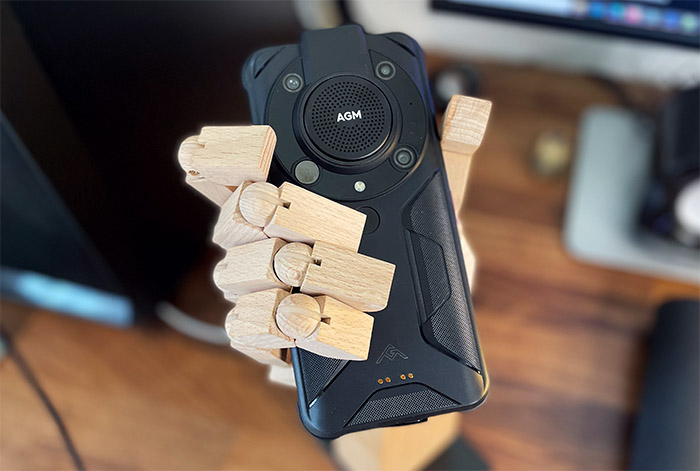The thermal cameras are getting more accessible to the general public, and the Xinfrared T2S+, the Topdown TC001, as well as the built-in module within the AG Glory Pro are proof that you don’t need to spend a lot of money to get a fairly reliable device. While before, the manufacturer made a point at attaching the thermal camera module to a dedicated display and built handle, these new devices are designed to work in a modular way and make use of the already existing resources of a smartphone.
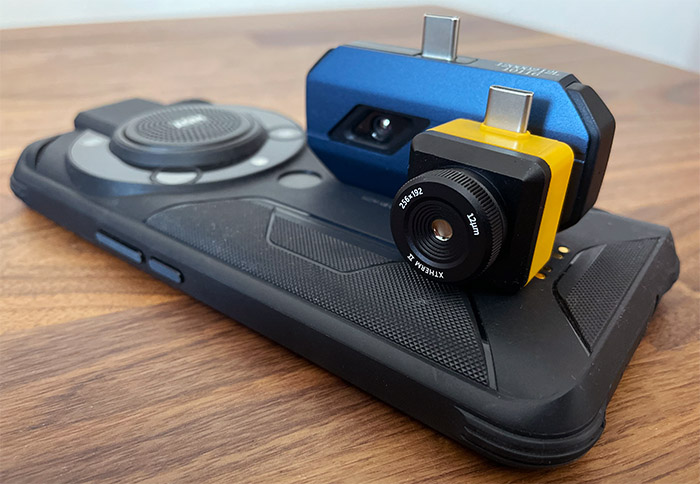
And I understand that in some cases this wall garden approach is beneficial to keep everything working properly, but I tested a few thermal camera that could connect to most Android smartphones on the market and aside from losing the access to the USB-C port, there aren’t that many things to complain about. Price-wise the Topdon TC001 and the Xinfrared T2S+ are very similar, so why did I add the AGM Glory Pro to the comparison?
It’s because AGM uses a built-in module that’s very similar to the two aforementioned modular thermal cameras and if you substract the hypothetical price of the smartphone, the module should cost pretty much the same as the T2S+ and the TC001. Of course, besides the performance, I will take the portability factor into account, as well as the app experience, so let’s check out these three devices and see if they’re a better option than the older and more established (as well as more expensive) brands out there.
Note: You can also check out the individual analysis of each thermal camera here: AGM Glory Pro, the Xinfrared T2S+ and Topdon TC001.
Design and Build Quality
One of the main selling points of the Xinfrared T2S+ is its ridiculous size. This module measures 1.0 x 1.0 x 0.9 inches and weighs 0.64oz, so it’s not only the more compact device from the bunch, it’s actually one of the most compact on the market.
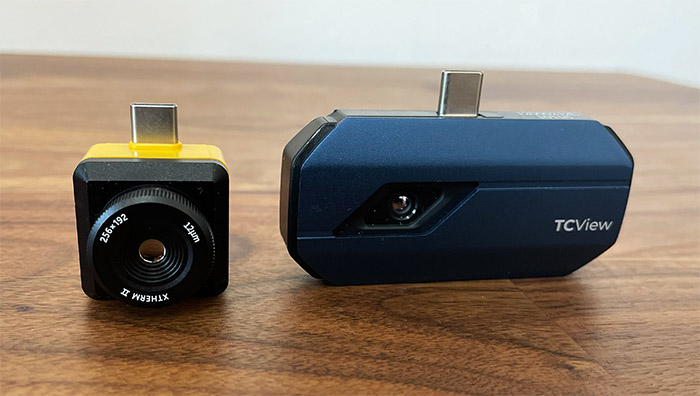
But, while the circular focus ring is the only metallic piece found on the Xinfrared T2S+, the Topdon TC001 has far more metal and, while not as small as the T2S+ (it measures 2.80 x 1.65 x 0.55 inches), it did go with a different approach. The device tries to mimic the lower part of the regular smartphone and I suppose it does manage to create that effect due to its angular design. The AGM Glory Pro is pretty much the opposite of the Xinfrared T2S+ and the Topdon TC001. It’s large, heavy and it can very well be used as a self defense weapon, but there is a reason for that.
AGM has focused towards offering the user a rugged smartphone to survive mechanical shocks and harsh environmental conditions. So, is the thermal camera just an afterthought? I initially thought so, but it is very well integrated and it seems that their implementation was well received since the manufacturer has just released a new smartphone with an even better thermal camera: the AGM G2 Guardian.
So, overall, the thermal camera on the Glory Pro is well protected and poses little risk at being damaged by shocks. That’s not really the case for the Topdon TC001 or the Xinfrared TS2+. Yes, I do like that both can connect to most Android phones and I don’t really need anything else (I mean, there’s a handle, but Xinfrared made it optional), but that USB-C port that points upwards is always going to be vulnerable to mechanical shocks. So you do need to be careful and detach the modules after each time you’re done using the thermal camera.
And both the Xinfrared T2S+ and the Topdon TC001 come with protective covers, especially useful for the T2S+ which can very easily be misplaced and forever lost (it’s pretty much the size of a quarter). There are no moving parts on the AGM Glory Pro or the TC001, so I suppose I do need to mention the focus ring which needs to be rotated manually to help with the macro photos.
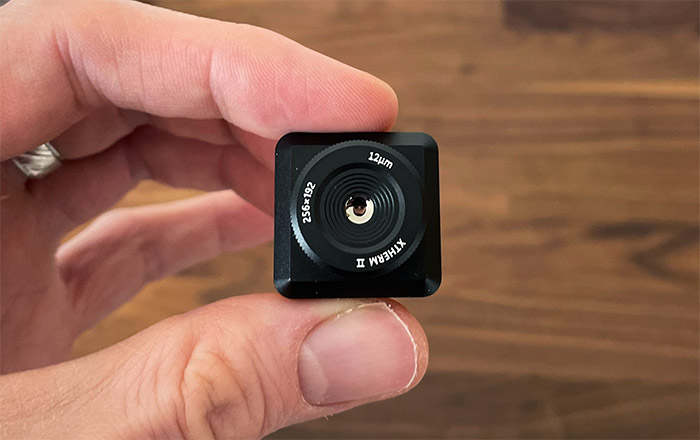
Xinfrared T2S+ vs Topdon TC001 vs AGM Glory Pro
Xinfrared T2S+
Topdon TC001
AGM Glory Pro
Resolution
256x192p
256x192p
256x192p
Frame Rate
25Hz
25Hz
25Hz
Battery
None – relies on phone
None – relies on phone
6,200mAh
Spot Meter
Yes
Yes
Yes
MSX (or alternative)
No
No
No
The Installation
| Xinfrared T2S+ | Topdon TC001 | AGM Glory Pro | |
| Resolution | 256x192p | 256x192p | 256x192p |
| Frame Rate | 25Hz | 25Hz | 25Hz |
| Battery | None – relies on phone | None – relies on phone | 6,200mAh |
| Spot Meter | Yes | Yes | Yes |
| MSX (or alternative) | No | No | No |
You don’t have to do anything to install the thermal camera on the AGM Glory Pro, it’s an integrated part of the software and yes, it does have a dedicated app. But both the Xinfrared T2S+ and the Topdon TC001 do require extra steps since they’re pretty much modules. That’s besides the plug process into the USB-C port, obviously.
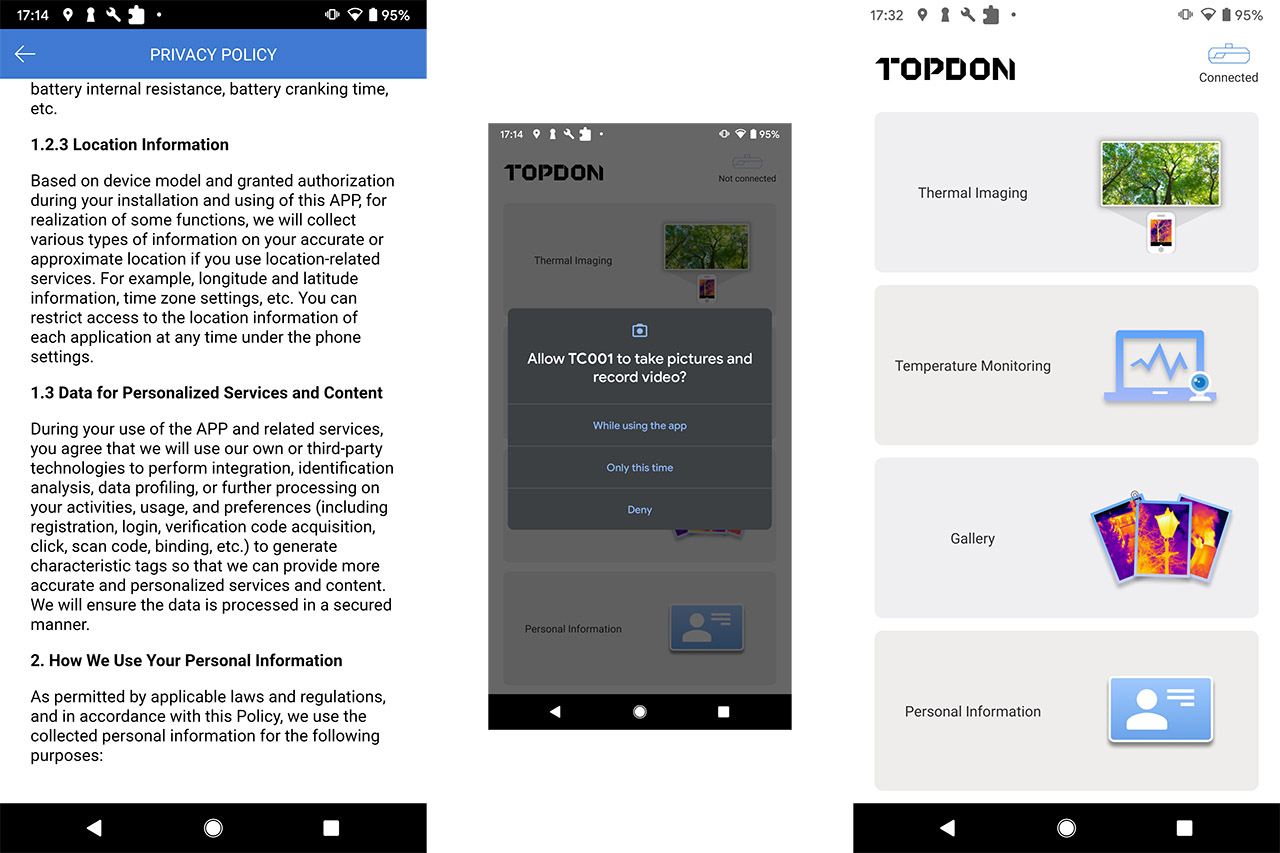
The Xinfrared T2S+ uses the Xtherm app, while the Topdon TC001 uses the TC001 app, and I am not sure if it’s a translating thing or not, but it was weird that the former did not require any permission for collecting data – it did before, when it was in Chinese, so it was a bit strange. Anyway, the Topdon TC001 app does ask for permission to collect data and it’s up to you how much you allow it to do so. Both apps will also ask for permission to the media, camera, Bluetooth which are necessary for the correct functioning of the modules. Also, it’s worth mentioning that neither apps required the creating of an account, which is great.
The Mobile Application
AGM has made sure that the thermal camera has its separate app and I do appreciate that they didn’t just implement it as a layer above the existing camera app. The app is called IRCamera and after starting it up, it will immediately show the temperature of the live view of the area in the color palette that you prefer.
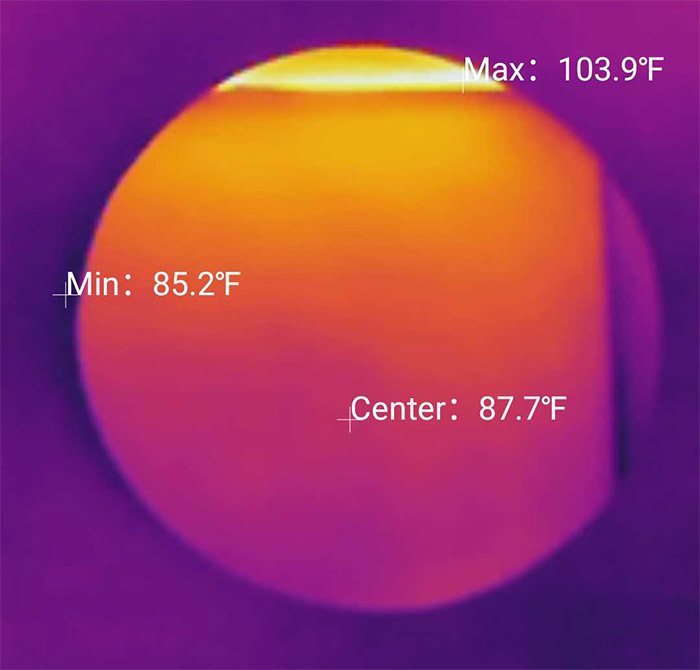
You can capture a photo or start filming and it’s also possible to take a Time-lapse snapshot of your environment. By default, the app will show the max, min and the center temperature, which is the same as on the Topdon TC001 app, but the Xinfrared T2S+ requires a few more steps to get the same view, as we will soon see. The AGM Glory Pro app will also give you access to some Settings, where you can change the Temperature Unit, as well as the Measurement Mode (it will adjust to colder or very hot areas).
Additionally, I saw that the app will also perform Auto calibrations and it’s also possible for it to store GPS info. The auto calibrations can be annoying since they will freeze the camera for a second and it will do so constantly, so, to limit it, it is possible to set a timer. Overall, it’s a fairly simple app, but offering all the features that the user may expect.
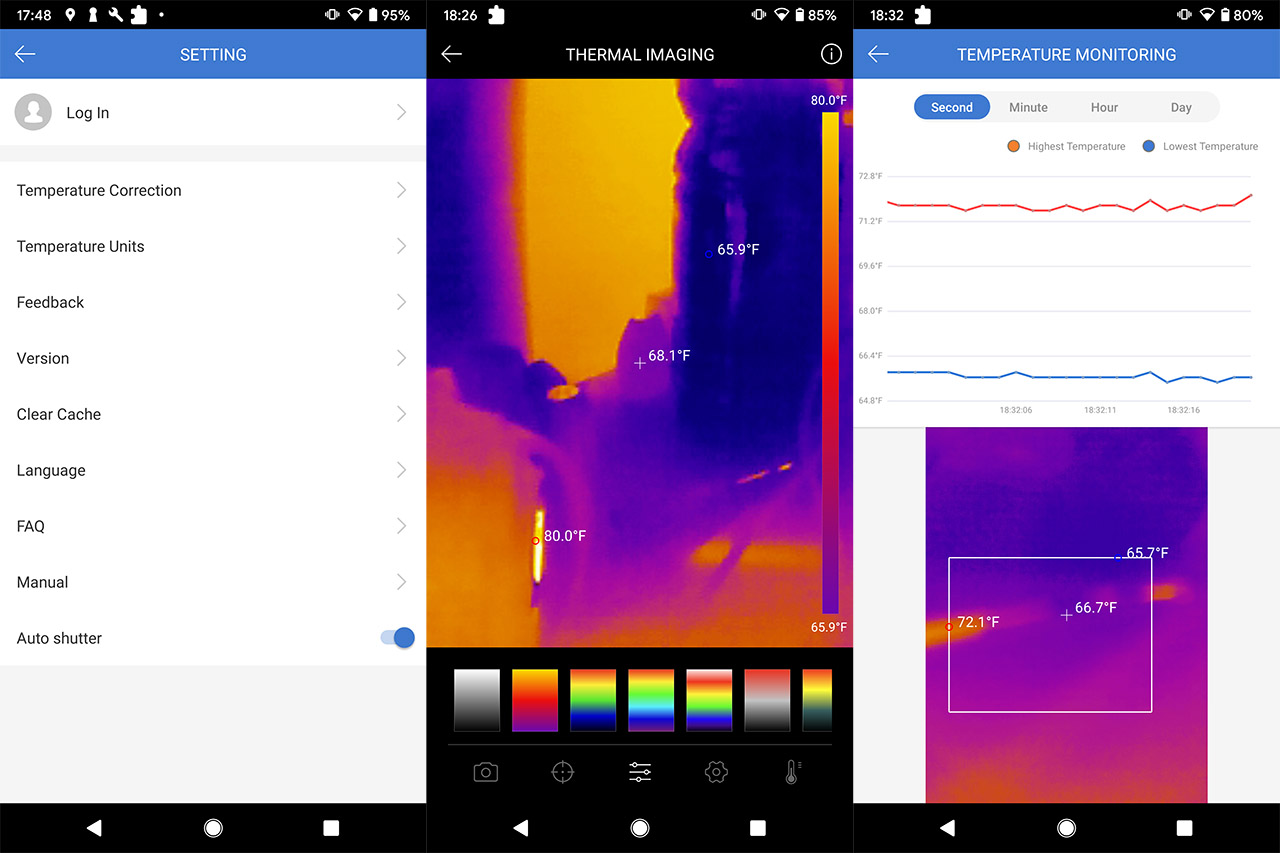
Moving to the Topdon TC001 app, we see that it offers pretty much the same suite of features as the Glory Pro, but it does have a few new elements. You can set areas of interest and check the Temperature Monitoring section for long-term results. You can also select the Details amount (by default, it’s set to Medium), as well as the Contrast, and I noticed that the app will allow you to check the temperature of a specific spot, along a line or within a drawn rectangular area.
The Xinfrared T2S+ Xtherm app offers a very similar set of features to the TC001, minus the ability to set the details. You can change the color palette, set areas which will show the temperature and, as I said before, the live view will not show the min, max and average by default. The workaround that I found was to simply draw a rectangle around the entire image.
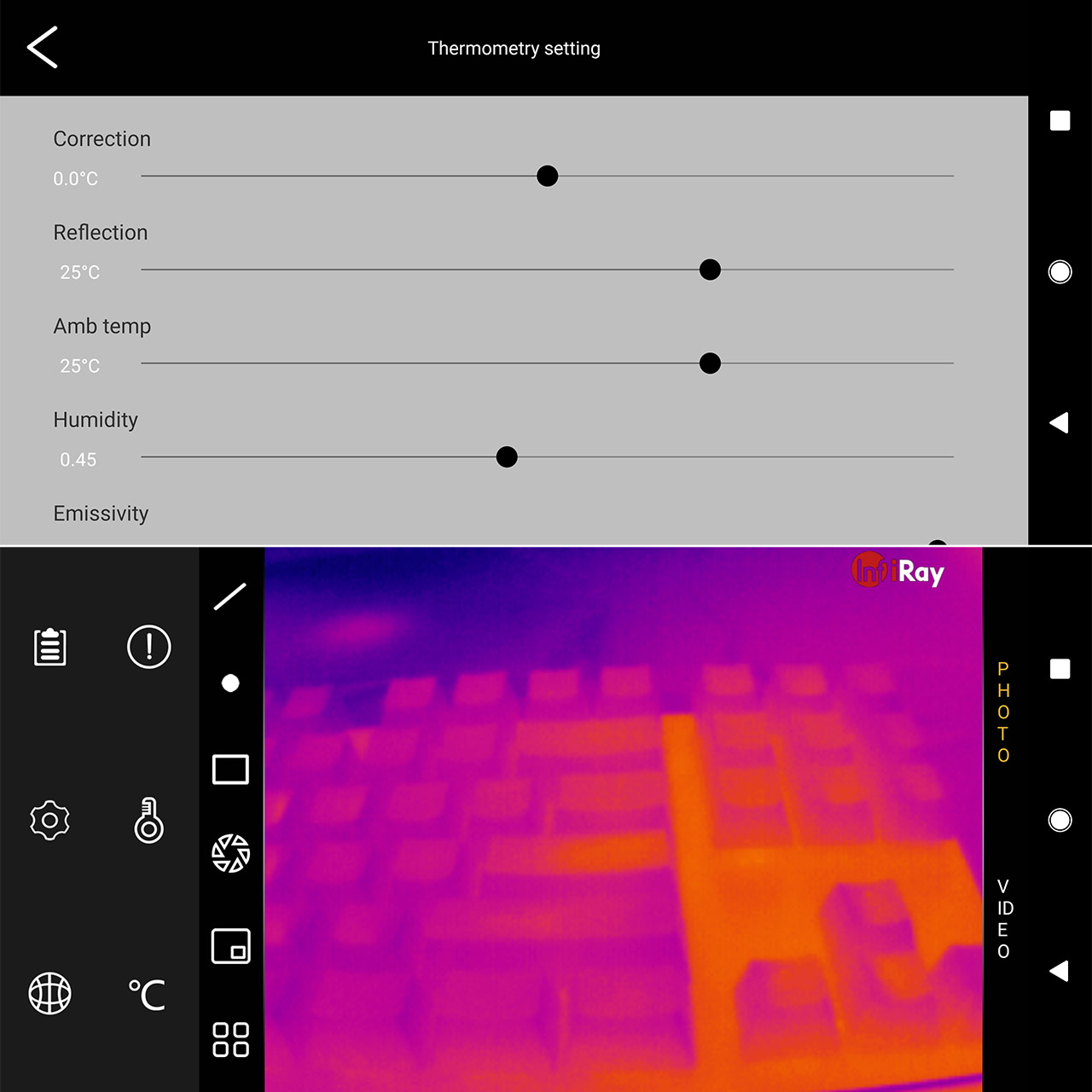
It’s worth mentioning that just like the AGM Glory Pro, the TC001 and the Xinfrared T2S+ do auto-calibrate often, but the Topdon thermal camera freezes less than the rugged smartphone, while the T2S+ auto-calibrates even less often (and when it does, there is less amount of screen freeze).
Each thermal camera in action: Quality, clarity and accuracy
I have already put exactly these three thermal cameras next to each other to see how well they performed and the results were a bit in favor to the Xinfrared T2S+ when I was closer to the subject, while the TC001 managed to offer a clearer view at a slightly longer range. It’s worth mentioning that all three thermal cameras offer the same resolution, 256×192 pixels and the refresh rate is 25Hz.
This is important because a thermal camera that’s developed in the US requires special permissions to be sold outside the country if the refresh rate exceeds 9Hz (and these certifications come at a cost, obviously). Which is why both SEEK and FLIR have their entry-level models stuck with a worse performing module than their counterparts developed in China (as an example).
When putting together the video which shows the three cameras side-by-side, I had to scale up the footage from both AGM Glory and the Topdon TC001, so, while they may seem like they have an edge on a smaller screen, that perceived advantage vanishes when the footage is properly put in perspective. Furthermore, I initially blamed the AGM Glory Pro for slowing down the footage, but it was actually the Topdon TC001 which for some weird reason accelerates it.
This means that I had to also slow down the footage from the TC001, besides scaling it. So, which one of the three thermal cameras is better? They’re very similar, so it isn’t easy to pick a winner. If we take the freezes from the auto-calibration into account, then the Glory Pro is pushed out of the competition, but it’s still able to reproduce very clear footage in the right conditions.
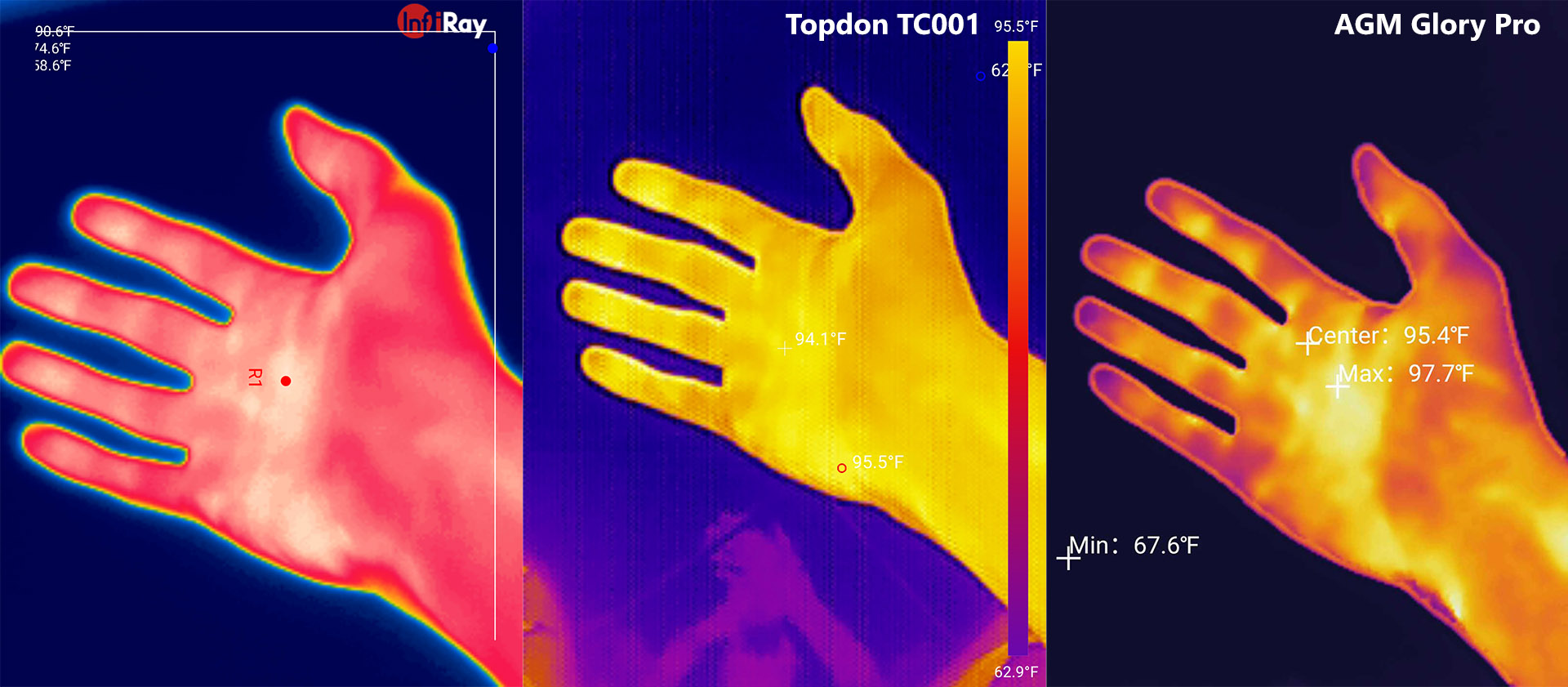
Also, if you don’t mind adjusting the focus of the 8mm lens, then the Xinfrared T2S+ could slightly outperform (or at least match) the Topdon TC001 even at a longer range. And, then again, the macro images and photos are better than expected, especially when checking electronic circuits. Are there better options out there? You bet there are, but the price tag is way, way higher.
The Conclusion
The conclusion is that you really don’t need to spend a lot of money to get a thermal camera that you can use at the hobby level. And yes, the AGM Glory Pro is more expensive than the two modules, but you still need a smartphone, so why not have two in one? If you’re not into large rugged devices, then the Topdon TC001 and the Xinfrared T2S+ got your back. As for the performance itself, I guess that the Xinfrared T2S+ could outperform both the TC001 and the Glory Pro, as long as you don’t mind constantly rotating the small focus ring. Otherwise, the TC001 has proven to be just as good if not better at longer distances, but do bear in mind the weird acceleration of the footage.

Mark is a graduate in Computer Science, having gathered valuable experience over the years working in IT as a programmer. Mark is also the main tech writer for MBReviews.com, covering not only his passion, the networking devices, but also other cool electronic gadgets that you may find useful for your every day life.

